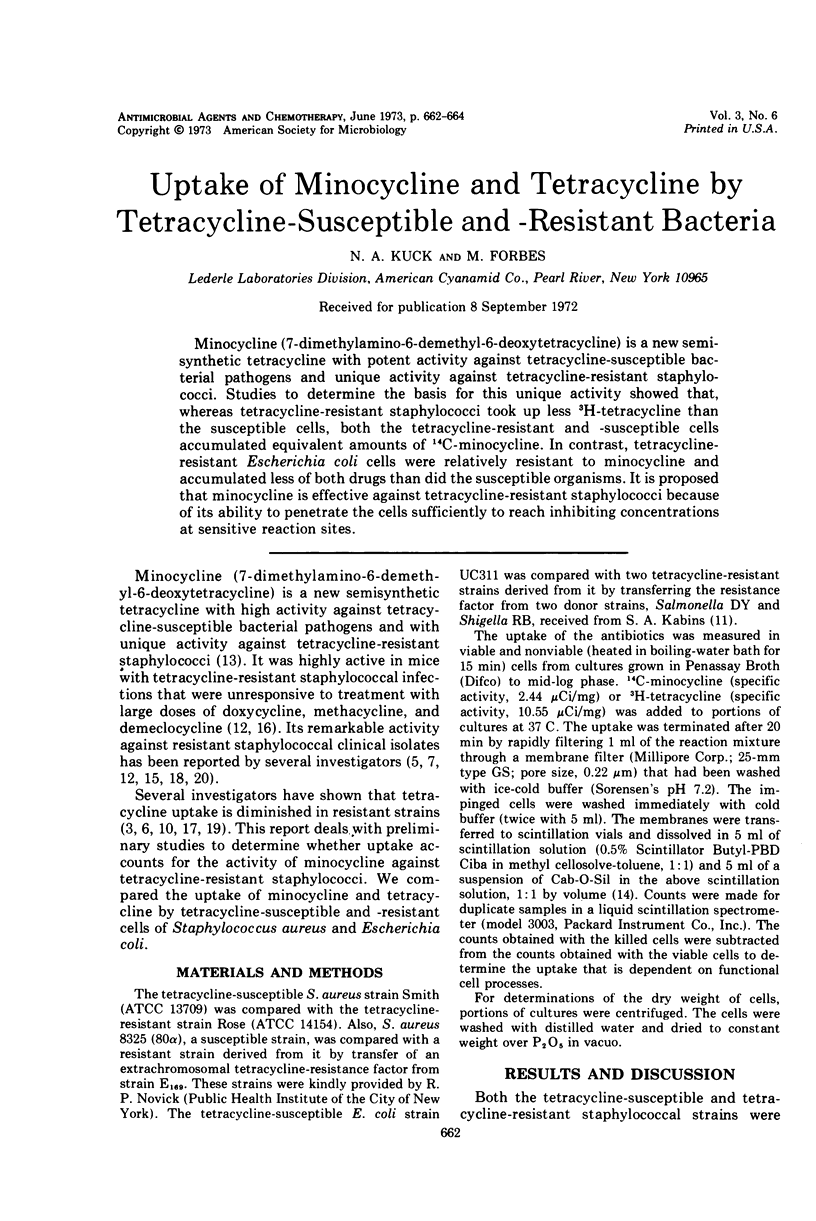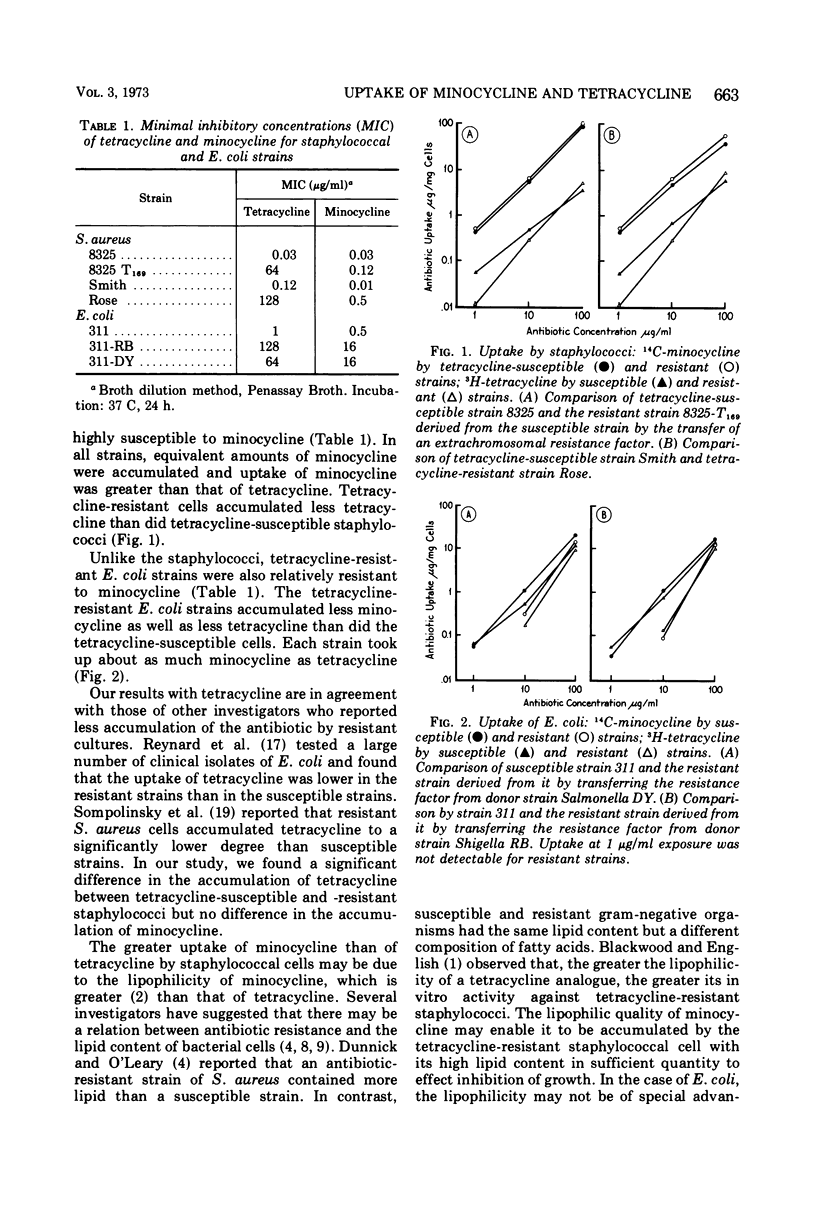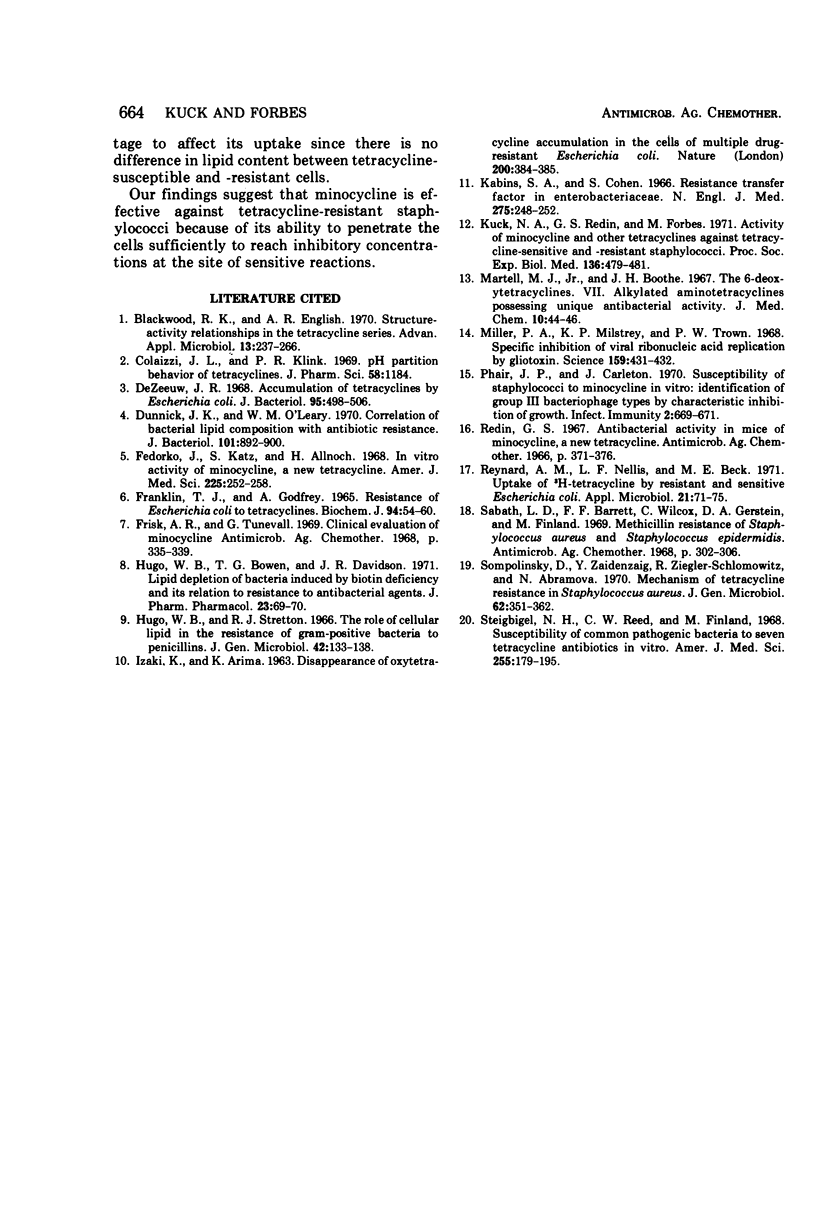Abstract
Minocycline (7-dimethylamino-6-demethyl-6-deoxytetracycline) is a new semisynthetic tetracycline with potent activity against tetracycline-susceptible bacterial pathogens and unique activity against tetracycline-resistant staphylococci. Studies to determine the basis for this unique activity showed that, whereas tetracycline-resistant staphylococci took up less 3H-tetracycline than the susceptible cells, both the tetracycline-resistant and -susceptible cells accumulated equivalent amounts of 14C-minocycline. In contrast, tetracycline-resistant Escherichia coli cells were relatively resistant to minocycline and accumulated less of both drugs than did the susceptible organisms. It is proposed that minocycline is effective against tetracycline-resistant staphylococci because of its ability to penetrate the cells sufficiently to reach inhibiting concentrations at sensitive reaction sites.
Full text
PDF


Selected References
These references are in PubMed. This may not be the complete list of references from this article.
- Colaizzi J. L., Klink P. R. pH-Partition behavior of tetracyclines. J Pharm Sci. 1969 Oct;58(10):1184–1189. doi: 10.1002/jps.2600581003. [DOI] [PubMed] [Google Scholar]
- De Zeeuw J. R. Accumulation of tetracyclines by Escherichia coli. J Bacteriol. 1968 Feb;95(2):498–506. doi: 10.1128/jb.95.2.498-506.1968. [DOI] [PMC free article] [PubMed] [Google Scholar]
- Dunnick J. K., O'Leary W. M. Correlation of bacteria lipid composition with antibiotic resistance. J Bacteriol. 1970 Mar;101(3):892–900. doi: 10.1128/jb.101.3.892-900.1970. [DOI] [PMC free article] [PubMed] [Google Scholar]
- FRANKLIN T. J., GODFREY A. RESISTANCE OF ESCHERICHIA COLI TO TETRACYCLINES. Biochem J. 1965 Jan;94:54–60. doi: 10.1042/bj0940054. [DOI] [PMC free article] [PubMed] [Google Scholar]
- Fedorko J., Katz S., Allnoch H. In vitro activity of minocycline, a new tetracycline. Am J Med Sci. 1968 Apr;255:252–258. doi: 10.1097/00000441-196804000-00006. [DOI] [PubMed] [Google Scholar]
- Frisk A. R., Tunevall G. Clinical evaluation of minocycline. Antimicrob Agents Chemother (Bethesda) 1968;8:335–339. [PubMed] [Google Scholar]
- Hugo W. B., Bowen J. G., Davidson J. R. Lipid depletion of bacteria induced by biotin deficiency and its relation to resistance to antibacterial agents. J Pharm Pharmacol. 1971 Jan;23(1):69–70. doi: 10.1111/j.2042-7158.1971.tb12787.x. [DOI] [PubMed] [Google Scholar]
- Hugo W. B., Stretton R. J. The role of cellular lipid in the resistance of gram-positive bacteria to penicillins. J Gen Microbiol. 1966 Jan;42(1):133–138. doi: 10.1099/00221287-42-1-133. [DOI] [PubMed] [Google Scholar]
- IZAKI K., ARIMA K. DISAPPEARANCE OF OXYTETRACYCLINE ACCUMULATION IN THE CELLS OF MULTIPLE DRUG-RESISTANT ESCHERICHIA COLI. Nature. 1963 Oct 26;200:384–385. doi: 10.1038/200384a0. [DOI] [PubMed] [Google Scholar]
- Jabara A. G. Three cases of primary malignant neoplasms arising in the canine urinary system. J Comp Pathol. 1968 Jul;78(3):335–339. doi: 10.1016/0021-9975(68)90010-8. [DOI] [PubMed] [Google Scholar]
- Kabins S. A., Cohen S. Resistance-transfer factor in Enterobacteriaceae. N Engl J Med. 1966 Aug 4;275(5):248–252. doi: 10.1056/NEJM196608042750504. [DOI] [PubMed] [Google Scholar]
- Kuck N. A., Redin G. S., Forbes M. Activity of minocycline and other tetracyclines against tetracycline-sensitive and -resistant staphylococci. Proc Soc Exp Biol Med. 1971 Feb;136(2):479–481. doi: 10.3181/00379727-136-35292. [DOI] [PubMed] [Google Scholar]
- Martell M. J., Jr, Boothe J. H. The 6-deoxytetracyclines. VII. Alkylated aminotetracyclines possessing unique antibacterial activity. J Med Chem. 1967 Jan;10(1):44–46. doi: 10.1021/jm00313a009. [DOI] [PubMed] [Google Scholar]
- Miller P. A., Milstrey K. P., Trown P. W. Specific inhibition of viral ribonucleic acid replication by Gliotoxin. Science. 1968 Jan 26;159(3813):431–432. doi: 10.1126/science.159.3813.431. [DOI] [PubMed] [Google Scholar]
- Phair J. P., Carleton J. Susceptibility of Staphylococci to Minocycline In Vitro: Identification of Group III Bacteriophage Types by Characteristic Inhibition of Growth. Infect Immun. 1970 Nov;2(5):669–671. doi: 10.1128/iai.2.5.669-671.1970. [DOI] [PMC free article] [PubMed] [Google Scholar]
- Redin G. S. Antibacterial activity in mice of minocycline, a new tetracycline. Antimicrob Agents Chemother (Bethesda) 1966;6:371–376. [PubMed] [Google Scholar]
- Reynard A. M., Nellis L. F., Beck M. E. Uptake of 3H-Tetracycline by resistant and sensitive Escherichia coli. Appl Microbiol. 1971 Jan;21(1):71–75. doi: 10.1128/am.21.1.71-75.1971. [DOI] [PMC free article] [PubMed] [Google Scholar]
- Sabath L. D., Barrett F. F., Wilcox C., Gerstein D. A., Finland M. Methicillin resistance of Staphylococcus aureus and Staphylococcus epidermidis. Antimicrob Agents Chemother (Bethesda) 1968;8:302–306. [PubMed] [Google Scholar]
- Sompolinsky D., Zaidenzaig Y., Ziegler-Schlomowitz R., Abramova N. Mechanism of tetracycline resistance in Staphylococcus aureus. J Gen Microbiol. 1970 Aug;62(3):351–362. doi: 10.1099/00221287-62-3-351. [DOI] [PubMed] [Google Scholar]
- Steigbigel N. H., Reed C. W., Finland M. Susceptibility of common pathogenic bacteria to seven tetracycline antibiotics in vitro. Am J Med Sci. 1968 Mar;255:179–195. doi: 10.1097/00000441-196803000-00005. [DOI] [PubMed] [Google Scholar]


